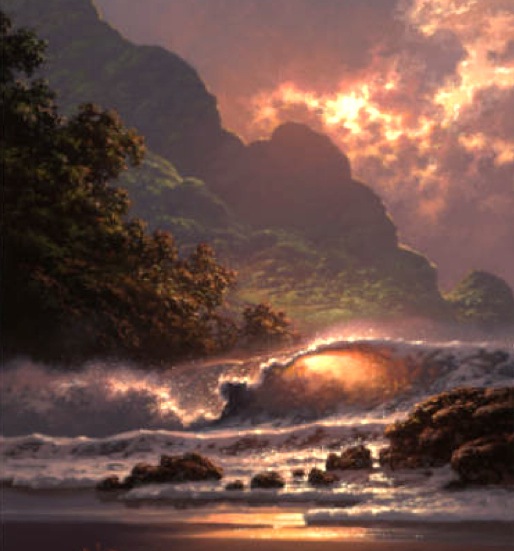 Image above: View of "Bali Hai" (Mount Makana) from website for Pricneville Kauai Vacation Rental website. From (http://www.kauaivacationrentals.com/static/374.html).
Image above: View of "Bali Hai" (Mount Makana) from website for Pricneville Kauai Vacation Rental website. From (http://www.kauaivacationrentals.com/static/374.html).
It's the second year in a row (and third time in five years) that Kauai topped the Hawaiian list among the magazine's readers, who were asked to rate the islands on five qualities: natural attractions, activities and sights, restaurants and food, people and value. Maui, Hawaii, O'ahu followed close behind, with Molokai in a more distant fifth place. On T+L's global list of best islands, Maui came in eighth and the Big Island 10th.
"People are touched by the serenity of Kauai's tropical beauty and how the island allows them to escape the stress of their daily lives and be rejuvenated by nature," said Sue Kanoho, executive director of the Kauai Visitors Bureau in a press release. "This is such a thrill for Kauai to again earn this recognition from Travel + Leisure's readers because of the strong message that it sends to travelers worldwide."
In the same prelease, Kauai Mayor Bernard Carvalho Jr. subtly referenced the ongoing battles on Kauai to keep its small-town charm and protect Native Hawaiian sites while allowing economic development and/or infrastructure improvements: "This award is shared by all of the people of Kauai who love our island, care for our island and work hard to make it one of the most special places on earth. We are honored that the readers of Travel + Leisure magazine recognize this and we will continue to share Kauai with the world in a way that preserves the beauty and character of our island home."
The generally friendly people of Kauai indeed make it very special, but understandably they can get frustrated by unchecked growth even as they increasingly rely on tourist dollars. While reading up on the Galápagos Islands, where tourism has grown exponentially in the last two decades, I was struck by the similarity in the stresses on its fragilie ecosystem and those on Kauai, the smallest (in size and population) of the four major islands. Read the "founding principles" of the International Galápagos Tour Operators Association, and imagine applying them to the Garden Isle:
Population Pressures: People are the beneficiaries of the islands; heritage, but they also present its most serious threat. We recognize that the islands offer a limited space for residents and visitors and insist that certain limits be imposed.
Human Settlement: The steep growth in population in the islands and the spread of permanent human settlements are in conflict with long-term economic and conservation goals. It is vital that the number of people moving to and settling on the islands be limited. At the same time, tourism can and should provide tangible benefits to the local populations. There should be improved living conditions created for those who are already there, particularly in educational, sanitation, and health-related areas.
Tourist Numbers: Uncontrolled growth of tourism to the islands will threaten the quality of the visitor experience, the economic viability of the industry, and the ecological integrity of the islands themselves. A carefully-designed plan, based on sound ecological and economic principles, is needed to control the growth and diversification of tourism.
Low Impact Nature Travel: The model of tightly controlled and organized nature-oriented tourism established in the Galapagos twenty-five years ago has served the islands well. Unspoiled nature is the attraction for travelers to the Galapagos. New types of tourism, however, are threatening to change the entire character and purpose of travel to the islands. Among these:
- There has been pressure to allow large passenger ships in excess of four hundred people, to operate in the islands.
- There have been proposals for new hotels, casinos, and air strips.
- Sport fishing has been introduced to the islands.
- There has been an increase in less motivated and less environmentally sensitive tour operators and travelers.
We are completely opposed to this movement away from low-impact nature tourism.
Of course, the Hawaiian Islands have a much different human history than the long-unpopulated Galápagos, and Ecuador's policies and resources are not the same as those of the United States, so it may be a little like comparing apples and naranjas. Yet I think the following maxim applies to both: As wonderful as it is to be recognized as a place full of wonders, it's important not to be loved to death. Or perhaps put more pithily: Endangered gooses lay golden eggs, but not after they're extinct.
Mahalo to all those on Kauai who do care about conservation, smart growth and stewardship, and to fellow visitors who try to tread lightly, support local growers and vendors, and elect environmentally conscious officials at the federal level.
 Image above: Detail of "Evening Blaze" by Roy Ganzales Tabora. This reproduction has been mirror images to show similarity to Mount Makena on Kauai. It is a highly romanticized and iconic vision of Kauai. Tobora is represented in galleries throughout Hawaii and sometimes paints in the lobby of the Waikiki Surfrider Hotel. From (http://www.taboragallery.com/RTeveningablaze.html).
Image above: Detail of "Evening Blaze" by Roy Ganzales Tabora. This reproduction has been mirror images to show similarity to Mount Makena on Kauai. It is a highly romanticized and iconic vision of Kauai. Tobora is represented in galleries throughout Hawaii and sometimes paints in the lobby of the Waikiki Surfrider Hotel. From (http://www.taboragallery.com/RTeveningablaze.html).
No comments :
Post a Comment